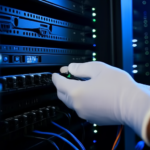“`html
5 Essential Tips for Protecting Your Network Privacy
Introduction
In today’s digital age, network privacy has become an increasingly critical concern for both individuals and organizations. With the rise of interconnected devices, cloud storage, and online transactions, the risk of data breaches, unauthorized access, and cyberattacks has grown exponentially. Protecting your network privacy is essential to safeguard sensitive information, maintain trust, and prevent financial and reputational damage.
Common threats to network privacy include data breaches, which can expose personal and financial details; unauthorized access, where hackers infiltrate systems to steal confidential information; and cyberattacks, which can disrupt operations and compromise sensitive data. Whether you’re an individual managing personal data or part of an organization handling customer information, understanding and implementing effective privacy measures is crucial.
This article provides five essential tips to help you protect your network privacy, ensuring a safer digital experience for everyone involved.
Tip 1: Use Strong, Unique Passwords
Passwords serve as the first line of defense against unauthorized access. A strong password acts as a barrier, making it more difficult for attackers to breach your network. However, weak or reused passwords can easily be cracked, leaving your data vulnerable.
To create a strong password, consider the following guidelines:
- Length: Aim for at least 12 characters, but longer is better.
- Complexity: Include a mix of uppercase and lowercase letters, numbers, and special characters.
- Avoid common words: Stay away from dictionary words, names, or easily guessable sequences.
Using a password manager is highly recommended. These tools generate and store strong passwords securely, eliminating the need to remember multiple complex combinations. They also help in generating unique passwords for each account, reducing the risk of widespread compromise if one password is compromised.
Tip 2: Enable Two-Factor Authentication (2FA)
Two-factor authentication (2FA) adds an extra layer of security by requiring a second form of verification beyond just a password. This method significantly reduces the risk of unauthorized access, even if an attacker manages to obtain your password.
There are several methods of 2FA, including:
- SMS-based: A code is sent to your mobile phone via text message.
- Authenticator apps: Apps like Google Authenticator or Authy generate time-sensitive codes.
- Hardware tokens: Physical devices that generate one-time codes.
Enabling 2FA for critical accounts and services, such as email, social media, and financial platforms, is a simple yet effective way to enhance security. Many devices and services offer built-in 2FA options, so take advantage of them whenever available.
Tip 3: Keep Software Up-to-Date
Regularly updating your operating systems, applications, and firmware is crucial for maintaining network privacy. Software updates often include critical security patches that address known vulnerabilities. These patches fix bugs and close loopholes that could otherwise be exploited by malicious actors.
Automating updates wherever possible ensures that you apply security patches promptly. Most modern operating systems and applications offer automatic update features, which can be configured to install updates without user intervention. For instance, Windows Update and macOS Software Update can be set to automatically download and install updates.
It’s also important to keep third-party applications up-to-date. Outdated software can introduce risks, especially if it hasn’t been updated in a long time. Regularly check for updates and apply them as soon as they become available.
Tip 4: Use a Reliable Firewall and Antivirus
Firewalls and antivirus software play vital roles in protecting your network from external threats. A firewall acts as a barrier between your internal network and the internet, monitoring and controlling incoming and outgoing traffic based on predefined security rules. Antivirus software, on the other hand, scans your system for malware, viruses, and other harmful software, removing or quarantining threats before they can cause damage.
Both firewalls and antivirus solutions are essential components of a robust security strategy. While a firewall prevents unauthorized access, antivirus software detects and neutralizes malicious software. Together, they provide comprehensive protection against a wide range of threats.
When choosing a firewall and antivirus solution, look for reputable brands with strong track records in security. Some popular options include:
- Windows Defender: Built into Windows operating systems, offers both firewall and antivirus protection.
- Malwarebytes: Known for its effective malware detection and removal capabilities.
- Norton Security Suite: Provides a comprehensive suite of security tools, including firewall, antivirus, and anti-phishing protection.
Best practices for configuring these tools include enabling real-time protection, scheduling regular scans, and keeping definitions up-to-date. Additionally, ensure that your firewall is properly configured to block unauthorized access while allowing legitimate traffic.
Tip 5: Educate Yourself About Phishing Attacks
Phishing attacks are a common method used by cybercriminals to exploit human error. These attacks typically involve fraudulent communications designed to trick individuals into revealing sensitive information or performing actions that compromise security. Phishers may send emails, messages, or create fake websites that appear legitimate but are actually traps.
To recognize phishing attempts, follow these strategies:
- Be cautious with unsolicited emails: Verify the sender’s identity before clicking on any links or downloading attachments.
- Look for suspicious URLs: Hover over links to see the actual URL and ensure it matches the expected domain.
- Watch out for urgency: Be wary of messages that create a sense of urgency, pressuring you to act quickly without thinking.
Organizations should implement regular training sessions and awareness programs to educate employees about phishing risks. By staying informed and vigilant, you can significantly reduce the likelihood of falling victim to these attacks.
Conclusion
Protecting your network privacy requires a combination of strong security practices and continuous vigilance. By following the five essential tips outlined in this article—using strong, unique passwords, enabling two-factor authentication, keeping software up-to-date, using reliable firewall and antivirus solutions, and educating yourself about phishing attacks—you can significantly enhance your security posture.
Remember, maintaining good cybersecurity hygiene is an ongoing process. Stay informed about new threats and protective measures, and encourage others to do the same. With the right precautions, you can enjoy a safer and more secure digital experience.
“`


